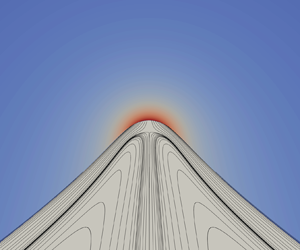Article contents
The emission properties, structure and stability of ionic liquid menisci undergoing electrically assisted ion evaporation
Published online by Cambridge University Press: 06 January 2022
Abstract

The properties and structure of electrically stressed ionic liquid menisci experiencing ion evaporation are simulated using an electrohydrodynamic model with field-enhanced thermionic emission in steady state for an axially symmetric geometry. Solutions are explored as a function of the external background field, meniscus dimension, hydraulic impedance and liquid temperature. Statically stable solutions for emitting menisci are found to be constrained to a set of conditions: a minimum hydraulic impedance, a maximum current output and a narrow range of background fields that maximizes at menisci sizes of 0.5–3  ${\rm \mu}{\rm m}$ in radius. Static stability is lost when the electric field adjacent to the electrode that holds the meniscus corresponds to an electric pressure that exceeds twice the surface tension stress of a sphere of the same size as the meniscus. Preliminary investigations suggest this limit to be universal, therefore, independent of most ionic liquid properties, reservoir pressure, hydraulic impedance or temperature and could explain the experimentally observed bifurcation of a steady ion source into two or more emission sites. Ohmic heating near the emission region increases the liquid temperature, which is found to be important to accurately describe stability boundaries. Temperature increase does not affect the current output when the hydraulic impedance is constant. This phenomenon is thought to be due to an improved interface charge relaxation enhanced by the higher electrical conductivity. Dissipated ohmic energy is mostly conducted to the electrode wall. The higher thermal diffusivity of the wall versus the liquid, allows the ion source to run in steady state without heating.
${\rm \mu}{\rm m}$ in radius. Static stability is lost when the electric field adjacent to the electrode that holds the meniscus corresponds to an electric pressure that exceeds twice the surface tension stress of a sphere of the same size as the meniscus. Preliminary investigations suggest this limit to be universal, therefore, independent of most ionic liquid properties, reservoir pressure, hydraulic impedance or temperature and could explain the experimentally observed bifurcation of a steady ion source into two or more emission sites. Ohmic heating near the emission region increases the liquid temperature, which is found to be important to accurately describe stability boundaries. Temperature increase does not affect the current output when the hydraulic impedance is constant. This phenomenon is thought to be due to an improved interface charge relaxation enhanced by the higher electrical conductivity. Dissipated ohmic energy is mostly conducted to the electrode wall. The higher thermal diffusivity of the wall versus the liquid, allows the ion source to run in steady state without heating.
- Type
- JFM Papers
- Information
- Copyright
- © The Author(s), 2022. Published by Cambridge University Press
References
REFERENCES
- 22
- Cited by





